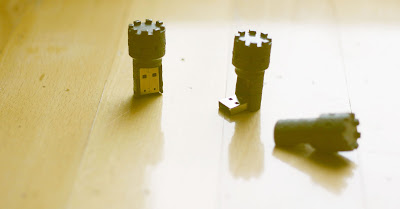Ever since
I started this blog, or, actually the reason that I started this blog, was to
develop an idea. When I started working with Arduino and other prototyping /
digital tools there was this spark that lid some part of my imagination, but I
never knew what to do with it. So I needed to bring more fuel to this spark.
Anyway,
later on I found that it is interesting to look at the friction between the
analogue and digital world. We’re all turning into more digital beings, where
our social lives are becoming more digital, our work is more digital and how we
create things is becoming more and more digital. One of the results in the
beginning of this digitalization is apples, then beloved and now hated,
Skeumorphism. To lead new users into this digital world a lot of metaphors have
been used to make it a quicker transition. We got our desktops back together
with our files and folders. And we could fill these in with our trusty
keyboard, the new typewriters.
This is all
said and done before, but with the new smart phones and tablets coming you see
a shift in what is possible. Now we have cameras and touch sensitive screens
that help make the interactions much more intuitive. Also with techniques like
the Kinect interacting with the digital world becomes more interesting.
Even though
the interaction with the digital world is becoming more diverse, the way that
the digital world interacts with us is mostly by images on screens and sounds. Of
course we also have printing and now 3d printing, even though it isn’t really
an interaction is it is a form of output.
So, where
I’m trying to get, is that it is an interesting space to explore: the
interaction of the digital in the analogue world. And I guess that this is
where Arduino can be (or is) at its strongest.
Examples
This lamp
exists out of 2 parts, one part stays at your house and the other in the house
of your partner. When you touch it, it lights up, but because of an internet
connection with the other lamp, that one also lights up, making your partner
aware that you turned on your light. And when both lamps are on they both shine
brighter.
It is a
very simple concept but it lets you share an emotion with just an ‘analogue’ interaction.
This is a
small cute printer that prints you tweets, new, puzzles or other things daily.
To have a good start of the day. With you smart phone you can select what kind
of prints you would like to get, and then you just need to wake up.
Again it is
a deceivingly simple concept, but a great interaction. By tearing of the
receipt like print, you have a nice way of getting your information. But also
as it just sits and smiles at you when it is done. It is a great way for your
digital world to become part of your analogue world.
This is a
small Processing / Arduino based CnC Bot. It has a small hand which can grab
something like a pen or small knive and it can move on three axes. It’s small
and inexpensive at thus easily to get hold of and to start experimenting with.
I think
this can be a very good way to let the digital world into the analogue world
and to leave a trace. I’m not sure how the processing sketch will work, but
with it you can probably also plug it into the web. and create cloud data based
sketches! :)
Okay, I’m
not sure yet where this will lead, especially since all these products are
still a work in progress or just not for sale. But I’m going to try to find out
more about it.
see you
next week!
frank















